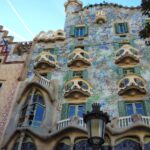
Antoni Gaudí, a pioneer of modernist architecture, left an indelible mark on the skyline of Barcelona with his extraordinary creations. His unique vision blends nature, religion, and innovation, resulting in structures that are both whimsical and breathtaking.
Among the most celebrated of his works are **Gaudí's Famous Barcelona Buildings**, which include the iconic Sagrada Familia and the playful Park Güell. These masterpieces not only attract millions of visitors each year but also exemplify the rich cultural heritage and artistic spirit of the city.
The Architectural Genius of Gaudí: Exploring His Most Iconic Barcelona Buildings
Antoni Gaudí's architectural genius is vividly showcased in several landmarks throughout Barcelona. His innovative style, characterized by organic forms and vibrant colors, often draws inspiration from the natural world. This connection to nature is evident in buildings like Casa Batlló, where the undulating facade resembles a dragon's back, and the interior mimics the shapes of marine life.
Another masterpiece, La Pedrera (Casa Milà), features a rooftop adorned with surreal chimneys that resemble warriors standing guard. Gaudí's use of trencadís, a technique involving broken ceramic tiles, adds a unique texture to his designs, further captivating the eyes of visitors. Key elements of his style include:
- Organic shapes that mimic natural forms
- Vibrant colors and intricate mosaics
- Innovative use of light and space
The Sagrada Familia remains Gaudí's most ambitious project, still under construction, and reflects his devotion to blending architecture with spirituality. With its towering spires and intricate facades, the basilica is a testament to his visionary approach. The juxtaposition of Gothic and Art Nouveau styles creates a harmonious yet avant-garde appearance that continues to inspire architects and artists worldwide.
In exploring Gaudí's iconic buildings, one cannot overlook the significance of his influence on Barcelona's cultural identity. His works have transformed the city into a mosaic of creativity, making it a hub for architectural enthusiasts. As you wander through the streets, you’ll discover:
| Building | Year of Completion | Style |
|---|---|---|
| Sagrada Familia | 1882 (ongoing) | Modernisme |
| Casa Batlló | 1906 | Modernisme |
| Park Güell | 1914 | Public Park |
| La Pedrera | 1912 | Modernisme |
A Detailed Look at the Sagrada Familia: Gaudí's Masterpiece in Barcelona
The Sagrada Familia stands as a monumental testament to Antoni Gaudí's architectural vision and spiritual dedication. This iconic basilica, with its towering spires and intricate details, combines elements of Gothic and Art Nouveau styles, creating a unique aesthetic that is both reverent and modern. Each facade tells a different story, reflecting Gaudí's profound connection to nature and his religious beliefs.
One of the most fascinating aspects of the Sagrada Familia is its ongoing construction, which began in 1882 and is still in progress. Gaudí meticulously planned the basilica to be completed with a total of 18 towers, symbolizing various biblical figures. The current projected completion date aims for 2026, aligning with the centenary of Gaudí's death, making it a poignant milestone for the city and the world.
Visitors to the Sagrada Familia can explore several remarkable features, including:
- The Nativity Facade: Celebrating the birth of Jesus, adorned with detailed sculptures and nature motifs.
- The Passion Facade: A stark contrast, depicting the suffering of Christ with a more austere and angular design.
- The interior: Designed to resemble a forest, with columns branching out like tree trunks, allowing natural light to filter through stained glass windows.
As a UNESCO World Heritage site, the Sagrada Familia not only highlights Gaudí's genius but also serves as a symbol of Barcelona's rich cultural heritage. Its unparalleled design continues to draw millions of tourists each year, making it an essential part of any visit to the city. The basilica is a living embodiment of Gaudí's artistic legacy, inspiring admiration and reflection among all who encounter it.
Park Güell: Nature and Art Combined in Gaudí's Vision
Park Güell is a stunning example of Antoni Gaudí's ability to merge nature and art. This vibrant public park, originally conceived as a residential area, showcases Gaudí's distinctive style through its colorful mosaics and organic shapes. The design reflects his philosophy of integrating architecture with the natural environment, creating a harmonious space where visitors can immerse themselves in beauty.
In Park Güell, natural elements are cleverly intertwined with artistic expressions. The park features pathways that mimic the undulating forms of the terrain and structures that resemble natural organisms. Gaudí's innovative use of trencadís, composed of broken ceramic pieces, enhances the park's whimsical appearance. Some of the notable elements include:
- The serpentine bench, which provides stunning views of the city
- The iconic salamander statue, known as "El Drac," symbolizing the fusion of nature and art
- Colorful mosaics that celebrate Catalan culture and landscape
The park is not only a feast for the eyes but also serves as a testament to Gaudí's visionary approach. His designs encourage visitors to explore and appreciate the intricate relationship between man-made structures and the natural world. By using elements like natural stone and vibrant colors, Gaudí invites us to experience a space that feels alive and dynamic.
Park Güell was declared a UNESCO World Heritage site, highlighting its cultural significance and the genius of Gaudí. As you stroll through its enchanting pathways, you'll discover how he transformed a former quarry into a landscape where nature and art coexist seamlessly, reflecting his unique architectural philosophy. The park remains a must-visit destination for anyone looking to delve into the heart of Gaudí's creativity.
Casa Batlló: A Symbol of Catalan Modernism by Gaudí
Casa Batlló, designed by Antoni Gaudí in 1906, stands as a vibrant symbol of Catalan Modernism. This architectural gem is renowned for its unique facade, characterized by a mosaic of colorful tiles that resemble the scales of a dragon—a tribute to the legend of Saint George, the patron saint of Catalonia. The building's organic shapes and flowing forms create a sense of movement, making it a visual feast for visitors and a testament to Gaudí's innovative style.
One of the most striking features of Casa Batlló is its roof, which resembles the back of a dragon, complete with a spine-like ridge that adds to its whimsical charm. The interior is equally breathtaking, with a light well that enhances natural illumination and a series of interconnected spaces that evoke the feeling of being submerged in a marine environment. Key elements of Casa Batlló include:
- Arched windows: These create an enchanting play of light and shadow.
- Curved walls: They reflect Gaudí's fascination with natural forms.
- Decorative elements: Such as stained glass and trencadís, which add texture and color.
Casa Batlló's innovative design not only showcases Gaudí's remarkable creativity but also serves as a representation of the spirit of Barcelona during the Modernisme movement. With its captivating aesthetics and rich symbolism, it has become a UNESCO World Heritage site, drawing architecture enthusiasts from around the globe. Visitors can experience the seamless integration of art and function, as well as the profound connection to Catalan culture embedded in every detail of the building.
In conclusion, Casa Batlló is more than just a building; it is an embodiment of Gaudí's vision and a celebration of the artistic identity of Barcelona. Its enduring legacy continues to inspire admiration and awe among those who explore its fantastical spaces, making it a must-see destination in the heart of the city.
Casa Milà (La Pedrera): The Innovative Design of Gaudí in Barcelona
Casa Milà, also known as La Pedrera, is a remarkable example of Antoni Gaudí's innovative design principles, completed in 1912. This striking building, characterized by its wavy stone facade and unique balconies, represents Gaudí's break from traditional architectural forms. The undulating exterior mimics the natural landscape, seamlessly integrating the structure with its surroundings. Visitors are often captivated by the way sunlight plays across the stone, creating a dynamic visual experience that shifts throughout the day.
One of the defining features of La Pedrera is its rooftop, which showcases a series of sculptural chimneys that resemble warriors or mythical creatures. This surreal skyline element not only serves a functional purpose but also adds to the building's whimsical character. Gaudí's use of trencadís on the chimneys and vents provides a textured finish that enhances the organic feel of the building, making it a true piece of art. Additionally, the rooftop offers stunning panoramic views of Barcelona, making it a popular spot for visitors.
The interior of Casa Milà is equally impressive, with a flexible layout that reflects Gaudí's innovative approach to residential design. The open floor plan allows light to permeate the space, creating a warm, inviting atmosphere. Key elements of the interior include:
- Curved walls: Designed to enhance sound distribution and create a fluid movement.
- Natural ventilation systems: Ingeniously integrated to ensure comfort without relying on artificial cooling.
- Decorative details: Intricately designed ironwork and wooden elements that highlight craftsmanship.
La Pedrera has been declared a UNESCO World Heritage site, cementing its status as one of Gaudí's most significant contributions to Barcelona's architectural landscape. As visitors explore this iconic landmark, they gain insight into Gaudí's visionary design philosophy, which harmonizes functionality and aesthetic beauty, making it a must-visit site for anyone interested in the avant-garde spirit of modernist architecture.
Discovering the Hidden Details in Gaudí's Barcelona Architecture
As you delve into Gaudí's architectural masterpieces in Barcelona, the hidden details within his designs reveal a world of creativity and inspiration. Each building is a canvas where nature's forms and colors come alive, often showcasing intricate motifs and symbolic elements. For instance, many of Gaudí's structures incorporate patterns inspired by flora and fauna, inviting visitors to discover the seamless relationship between architecture and the natural environment.
One captivating aspect is Gaudí's use of light, which transforms spaces and emphasizes details that might otherwise go unnoticed. The interplay of light and shadows creates a dynamic atmosphere, particularly in the Sagrada Familia and Casa Batlló. Here are some hidden features to look out for:
- Stained glass windows: Each piece is uniquely crafted to filter light in vibrant colors.
- Curved surfaces: These enhance acoustics and create a sense of flow throughout the interiors.
- Symbolic sculptures: Many facades feature animals or plants that align with Gaudí's love for nature.
Moreover, Gaudí's clever incorporation of functional design elements adds to the charm of his buildings. For example, at La Pedrera, the chimneys not only serve a practical purpose but are also sculptural masterpieces that reflect the whimsical character of the structure. Each detail tells a story, urging visitors to explore and appreciate the artistry behind every curve and surface.
Ultimately, discovering the hidden details in Gaudí's architecture is an enriching experience that elevates one's understanding of his genius. As you navigate through Barcelona, take time to admire the nuances and craftsmanship that define his legacy, making each visit a journey of discovery filled with wonder and admiration.
 Gaudí's Masterpiece: Casa Batlló
Gaudí's Masterpiece: Casa Batlló Famous Modernist Buildings in Barcelona
Famous Modernist Buildings in BarcelonaIf you want to know other articles similar to Gaudí's Famous Barcelona Buildings you can visit the category WHERE YOU CAN GO.
Leave a Reply










Read more!